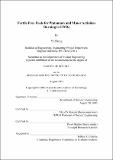Fertile free fuels for plutonium and minor actinides burning in LWRs
Author(s)
Zhang, Yi
DownloadFull printable version (634.8Kb)
Alternative title
Fertile free fuels for plutonium and minor actinides burning in light water reactors
Other Contributors
Massachusetts Institute of Technology. Dept. of Nuclear Engineering.
Advisor
Mujid S. Kazimi.
Terms of use
Metadata
Show full item recordAbstract
The feasibility of using various uranium-free fuels for plutonium incineration in present light water reactors is investigated. Two major categories of inert matrix fuels are studied: composite ceramic fuel particles dispersed in another ceramic matrix (CERCER) and ceramic fuel particles dispersed into a metallic matrix (CERMET). In the category of CERCER, the current world wide research effort has been focused on three matrix candidates: (1) Spinel (MgAl2O4); (2) CeO2, and (3) MgO. In contrast, there are still no emerging commonly accepted matrix candidates for a CERMET. The fuel may consist of plutonium, minor actinides (MA), or both which are termed trans-uranium (TRU) fuel. The transmutation rate and the transmuted fraction of initial loadings are calculated using CASMO-4. Different inert matrix fuels have similar burning abilities in terms of how much and how fast the Pu, MA or TRU can be burned, and they are all superior to the mixed UO2-PuO2 (MOX) fuel. From this point of view, there is no good reason to favor one inert matrix over another. The burning rates in terms of kg/(GWe-Year) of different inert matrix fuels are quite stable with regard to changing the moderation level (or H/HM ratio) in the core. Changing initial loadings and changing power densities can not result in large change in the burned percentage of initial loadings and burning rate. Lack of U-238 and the neutronic characteristics of plutonium lead to degradation of safety related kinetic parameters. It is found that various inert matrix fuels have similar values for the Doppler coefficient, moderator temperature coefficient, void coefficient, boron worth and effective delayed neutron fraction [beta]eff. But their Doppler coefficients are much smaller than those of MOX and UO2 fuels. Both inert matrix fuels and MOX fuel have a much smaller effective delayed neutron fraction than UO2 fuel. IMF fuel's value is smaller than that of UO2 fuel, but close to that of MOX. The void coefficient is also a potential problem. The coolant void reactivity worth becomes positive if the void fraction reaches 80 percent at beginning of life for boron concentration of 1500 ppm. This is confirmed by MCNP- 4C and modified CASMO-4 calculations. The situation is generally much worse at BOL than at EOL. This is of concern during loss of coolant accidents. Two options are explored in order to improve safety coefficients: 1. Adding fertile materials into IMF fuel pins; 2. Adding fertile fuel pins into IMF fuel assemblies. UO2 and ThO2 are used as fertile additives. In option 1 it is found that adding UO2 will result in a worse degradation of burning ability. However, adding UO2 provides a better Doppler coefficient than adding ThO2. Adding about 20 w/o of UO2 achieves a BOL Doppler coefficient and other safety coefficients comparable to the traditional UO2 fuel. Yet, the fuel still has a much better burning percentage than MOX fuel for Pu (47.5% versus 13.2%) and for MA (36.1% versus 19.0%), and a much better burning rate for Pu (834 versus 285 kg/GWe-Year) and for MA (98 versus 63 kg/GWe-Year). In option 2 it is found that in order to reach the same level of safety coefficients, the burning rate of the minor actinides becomes comparable to that of MOX: 68.7 versus 63.3 kg/GWe-Year. Thus the option of adding fertile material into the fuel pins is preferable over a heterogeneous assembly option if fast burning of minor actinides is favored.
Description
Thesis (S.M.)--Massachusetts Institute of Technology, Dept. of Nuclear Engineering, 2003. Includes bibliographical references (p. 126-128). This electronic version was submitted by the student author. The certified thesis is available in the Institute Archives and Special Collections.
Date issued
2003Department
Massachusetts Institute of Technology. Department of Nuclear Engineering; Massachusetts Institute of Technology. Department of Nuclear Science and EngineeringPublisher
Massachusetts Institute of Technology
Keywords
Nuclear Engineering.